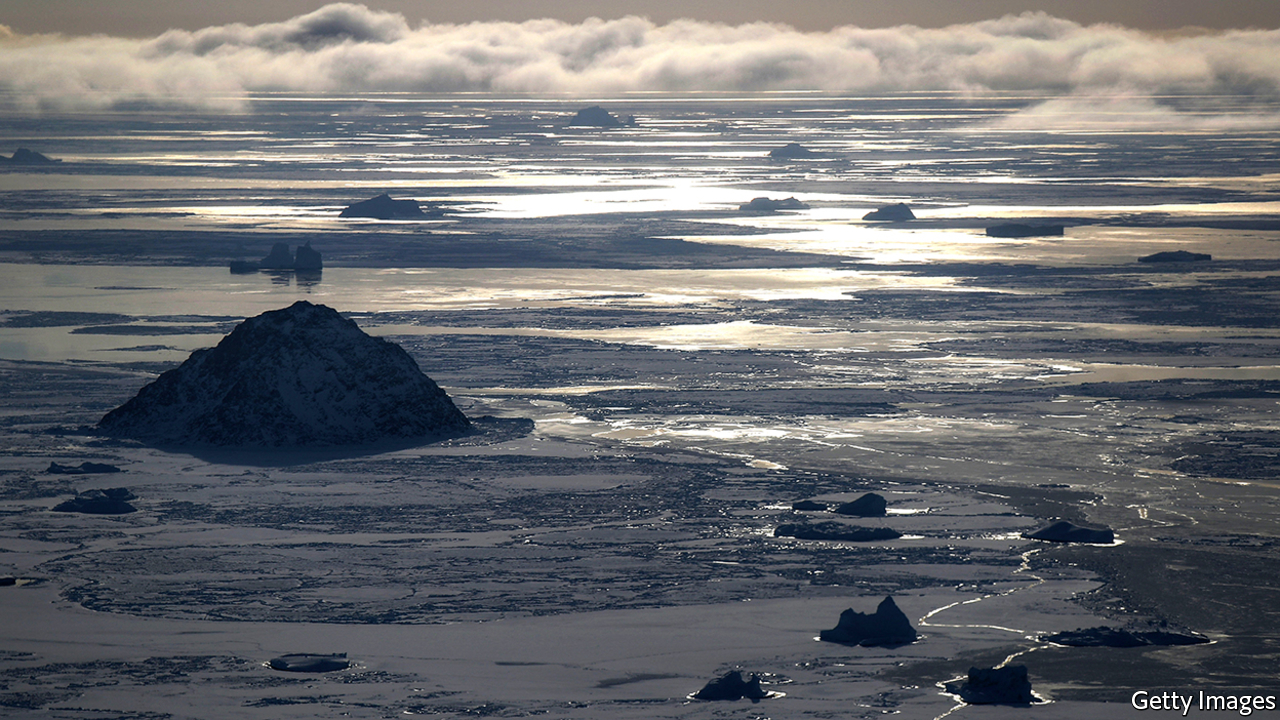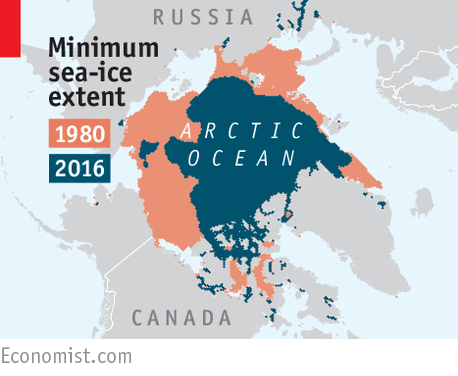
The Arctic as it is known today is almost certainly gone
On current trends, the Arctic will be ice-free in summer by 2040
The Economist | 29 April 2017
THOSE who doubt the power of human beings to change Earth’s climate should look to the Arctic, and shiver. There is no need to pore over records of temperatures and atmospheric carbon-dioxide concentrations. The process is starkly visible in the shrinkage of the ice that covers the Arctic ocean. In the past 30 years, the minimum coverage of summer ice has fallen by half; its volume has fallen by three-quarters. On current trends, the Arctic ocean will be largely ice-free in summer by 2040.

Climate-change sceptics will shrug. Some may even celebrate: an ice-free Arctic ocean promises a shortcut for shipping between the Pacific coast of Asia and the Atlantic coasts of Europe and the Americas, and the possibility of prospecting for perhaps a fifth of the planet’s undiscovered supplies of oil and natural gas. Such reactions are profoundly misguided. Never mind that the low price of oil and gas means searching for them in the Arctic is no longer worthwhile. Or that the much-vaunted sea passages are likely to carry only a trickle of trade. The right response is fear. The Arctic is not merely a bellwether of matters climatic, but an actor in them (see Briefing).
The current period of global warming that Earth is undergoing is caused by certain gases in the atmosphere, notably carbon dioxide. These admit heat, in the form of sunlight, but block its radiation back into space, in the form of longer-wavelength infra-red. That traps heat in the air, the water and the land. More carbon dioxide equals more warming—a simple equation. Except it is not simple. A number of feedback loops complicate matters. Some dampen warming down; some speed it up. Two in the Arctic may speed it up quite a lot.
One is that seawater is much darker than ice. It absorbs heat rather than reflecting it back into space. That melts more ice, which leaves more seawater exposed, which melts more ice. And so on. This helps explain why the Arctic is warming faster than the rest of the planet. The deal on climate change made in Paris in 2015 is meant to stop Earth’s surface temperature rising by more than 2°C above pre-industrial levels. In the unlikely event that it is fully implemented, winter temperatures over the Arctic ocean will still warm by between 5° and 9°C compared with their 1986-2005 average.
The second feedback loop concerns not the water but the land. In the Arctic much of this is permafrost. That frozen soil locks up a lot of organic material. If the permafrost melts its organic contents can escape as a result of fire or decay, in the form of carbon dioxide or methane (which is a more potent greenhouse gas than CO2). This will speed up global warming directly—and the soot from the fires, when it settles on the ice, will darken it and thus speed its melting still more.
A warming Arctic could have malevolent effects. The world’s winds are driven in large part by the temperature difference between the poles and the tropics. If the Arctic heats faster than the tropics, this difference will decrease and wind speeds will slow—as they have done, in the northern hemisphere, by between 5 and 15% in the past 30 years. Less wind might sound desirable. It is not. One consequence is erratic behaviour of the northern jet stream, a circumpolar current, the oscillations of which sometimes bring cold air south and warm air north. More exaggerated oscillations would spell blizzards and heatwaves in unexpected places at unexpected times.
Ocean currents, too, may slow. The melting of Arctic ice dilutes salt water moving north from the tropics. That makes it less dense, and thus less inclined to sink for the return journey in the ocean depths. This slowing of circulation will tug at currents around the world, with effects on everything from the Indian monsoon to the pattern of El Niño in the Pacific ocean.
The scariest possibility of all is that something happens to the ice cap covering Greenland. This contains about 10% of the world’s fresh water. If bits of it melted, or just broke free to float in the water, sea levels could rise by a lot more than today’s projection of 74cm by the end of the century. At the moment, the risk of this happening is hard to assess because data are difficult to gather. But loss of ice from Greenland is accelerating.
What to do about all this is a different question. Even if the Paris agreement is stuck to scrupulously, the amount of carbon dioxide already in the atmosphere, together with that which will be added, looks bound eventually to make summer Arctic sea ice a thing of the past. Some talk of geoengineering—for example, spraying sulphates into the polar air to reflect sunlight back into space, or using salt to seed the creation of sunlight-blocking clouds. Such ideas would have unknown side-effects, but they are worth testing in pilot studies.
The hard truth, however, is that the Arctic as it is known today is almost certainly gone. Efforts to mitigate global warming by cutting emissions remain essential. But the state of the Arctic shows that humans cannot simply undo climate change. They will have to adapt to it.


No comments:
Post a Comment